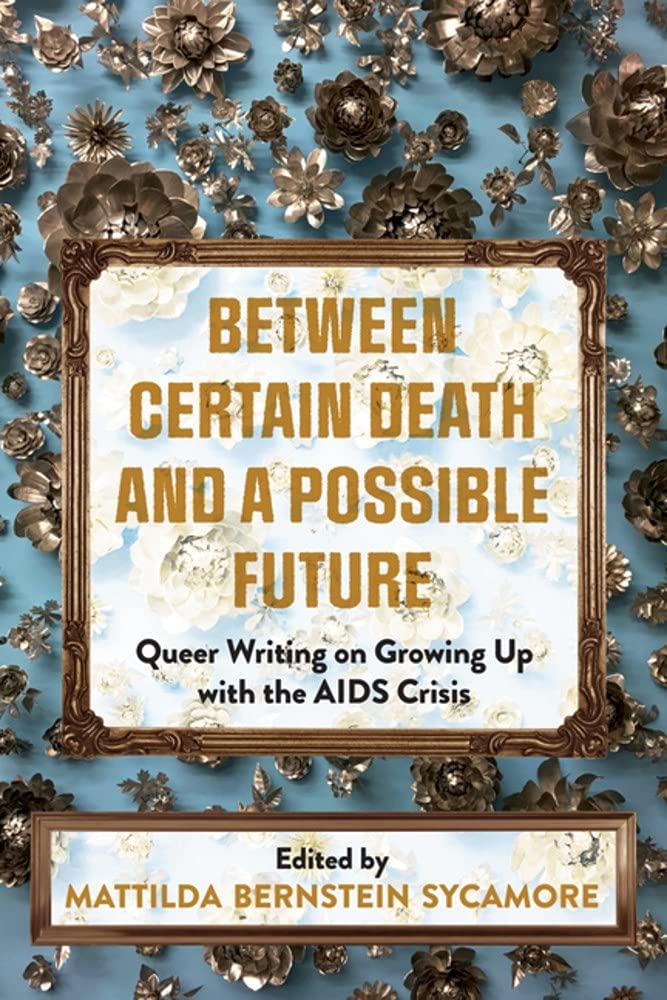
ANTHOLOGY
Between Certain Death and a Possible Future: Queer Writing on Growing Up with the AIDS Crisis
ed. Mattilda Sycamore
Arsenal Press
Paperback, ISBN: 978-1-55152-850-2, 368 pages, $22.95
October 5, 2021
Today, a generation of children grapple with the stark reality of a shadowy plague that could silently pass to them from family and friends and, almost worse, be passed by them to others. Treachery, deadly and faceless, intrudes at the forefront of their childhood. And they are not the first innocents to tremble under this sword of Damocles.
Lambda Literary Award-winning writer Mattilda Bernstein Sycamore edits this important, poignant, unvarnished, and gritty collection of voices from a caste-like margin of infection, a perspective heretofore largely unexplored by the majority until another viral plague skipped all demographic margins and blanketed the mainstream as well. Before that, and since, these inscribed stories play out in a deafening silence that deserves, demands articulation.
The narrative voices are those of the first generation whose sexuality landed them in the epicenter of the AIDS virus, a lethal whirlwind then only just-detected and crudely defined, well before revolutionary, life-prolonging HIV therapies became routine. According to Sycamore, they inherited, as a result, a learned belief that desire intrinsically led to death. And then, they tried to live their lives.
“After a year of dating,” one testimony unfolds, “He sat me down on a park bench during a summer afternoon and told me he couldn’t be in a relationship with someone when he knew they were going to die.” This, from within the vulnerable margin that nevertheless, according to the writer, shared “an ethos of queer collective care” that evolved from the early days of HIV response, when prevention was conceptualized as a shared responsibility. And yet within the gay community itself, there exists stigma and victimization. In his own country, the writer sighs, one which celebrates and overtly embraces rainbow diversity, there remains a net of criminality overarching the brutal reality of HIV. So, added to the harm of potential infection is the hatred of a general public mandating, and the police enforcing, the criminalization of HIV infection. Then sexuality is constrained within boundaries limned by the police and the criminal justice system. “To many of us living with the virus,” the writer confides, “fear is the real problem, not HIV.”
Readers walk through the essential experience of an AIDS clinic, where a subtext of community binds the afflicted: “Whether they are A-gays or C-gays,” the testimony reads, “I feel a camaraderie with the others … the lab has a way of leveling the playing field. It all comes down to bloodwork.” Entirely relatable, from the equalizing forces of clinical service, terminal disease, and life-prolonging therapy. Entirely deplorable, nonetheless, is the contrast of stigma, or the comparative lack, in HIV versus socially normalized terminal illnesses such as cancer or dementia. Therein lies the constructive purpose for this anthology landing outside of the LGBTQ community: the history should transcend the stigma to be known and must be inscribed to endure. And people, left, right, and middle, need to know.
The reader should be aware going in that there is graphic sexual content in this collection. The impact and authenticity of the narratives stem from their borderline aggressive bluntness. When that directness is generalized, the tragedy and history is sufficiently palpable: “We both tested positive … I wasn’t diagnosed with just HIV but with AIDS. The virus sharpened from a historical abstraction into reality: blood tests, prescriptions, side effects, the healthcare system, telling my mom, and the tearful screaming between my partner and me.” When the visceral grit of the narratives is explicit, which it consistently is, the anthology may be too overwhelmingly unpalatable for those any substantial distance from the margin from which the voices speak.
That would be yet another tragic paradox, another barrier to understanding and compassion, but completely understandable, predictable even. Regardless, the history is imperative, authentic, truthful, tragic, and enduring. That alone, for anyone who would know the reality behind the layers of stigma, fear, and swirling shame that fogs the truth of a deadly pandemic virus, past, present, and yet to come, is sufficient reason to take this anthology on.
Mattilda Bernstein Sycamore is the author of two non-fiction titles and three novels, and the editor of five non-fiction anthologies. Her latest title, The Freezer Door, is a New York Times Editors' Choice, one of O - The Oprah Magazine's Best LGBTQ Books of 2020, and a finalist for both the PEN/Jean Stein Book Award and a Lambda Literary Award. Her memoir, The End of San Francisco, won a Lambda Literary Award in 2014, and her novel Sketchtasy was one of NPR's Best Books of 2018. Her anthology Why Are Faggots So Afraid of Faggots?: Flaming Challenges to Masculinity, Objectification, and the Desire to Conform was an American Library Association Stonewall Honor Book. Her latest anthology (her sixth) is Between Certain Death and a Possible Future: Queer Writing on Growing Up with the AIDS Crisis, publishing in fall 2021. Her nonfiction book Touching the Art will be published by Soft Skull in 2023. She lives in Seattle.
